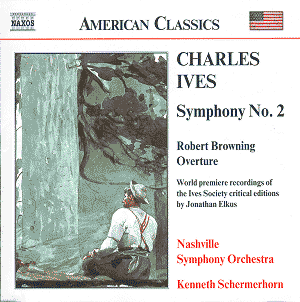Charles IVES (1874 -
1954)
Symphony No. 2
Robert Browning Overture
 Nashville Symphony
Orchestra/Kenneth Schermerhorn
Nashville Symphony
Orchestra/Kenneth Schermerhorn
Recorded Tennessee Performing Arts centre, Nashville, June 2000
 NAXOS 8.559076
[66.30]
NAXOS 8.559076
[66.30]
Crotchet
AmazonUK
AmazonUS

Ives is one of the great originals of 20th century music, and the two works
on this disc reflect that fact. The Second Symphony is a relatively
early work, begun at the very beginning of the century when Ives was just
setting out on his career as a 'serious' composer. The Robert Browning
Overture came a little later, having been started in 1908.
Neither is a completely satisfactory work. The overture is a decidedly strange
piece, and reflects a side of Browning, or perhaps rather a response to him,
that will probably seem quite odd to most British listeners. It alternates
dark, brooding and rather tense music with wild, blundering march-like passages,
driven forward by typical Ivesian twos-against-threes.
The symphony is nominally in five movements, though the short fourth movement
is probably best seen as a prelude to the finale. In its course, many popular
American tunes put in an appearance, as is often the case with Ives. It opens
with a leisurely Andante moderato, scored mainly for strings. Melodies
quoted here include Pig Town Fling and Columbia, the Gem of the
Ocean. The longer and more involved quick movement that follows occasions
some alert and attractive woodwind playing from the Nashville orchestra.
(Is it just me, or is there a sly reference to the first movement of Brahms'
3rd Symphony at 3'30"?)
The solemn Adagio third movement begins with an allusion to the song
now known as America the Beautiful. Lovely as this movement is, I
find it less convincing than the others; in it, Ives typically discursive
manner seems just a touch too loose, leading to an uncertain sense
of direction. As if to remedy this, the short fourth movement reminds us
of the sternness of the opening, before leading into the rollicking finale.
This is easily the most eventful and enjoyable part of the work, featuring
references to the jolly tune Camptown Races and an increasing feeling
of hilarity. The famous (notorious?) final resounding dissonance is described
in the notes as a 'symphonic pie-in-the-face'. Nicely put!
These are worthy rather than outstanding performances. The orchestral playing,
though not distinguished, is tidy and stylish enough. Everything is in place,
intonation, ensemble and internal balance are mostly good, etc., etc. Yet
there is something very unsatisfying about the recording. It lacks any sense
of perspective, and has a boxy, unreal sound - disappointing by Naxos' usually
high standards.
Gwyn Parry-Jones

